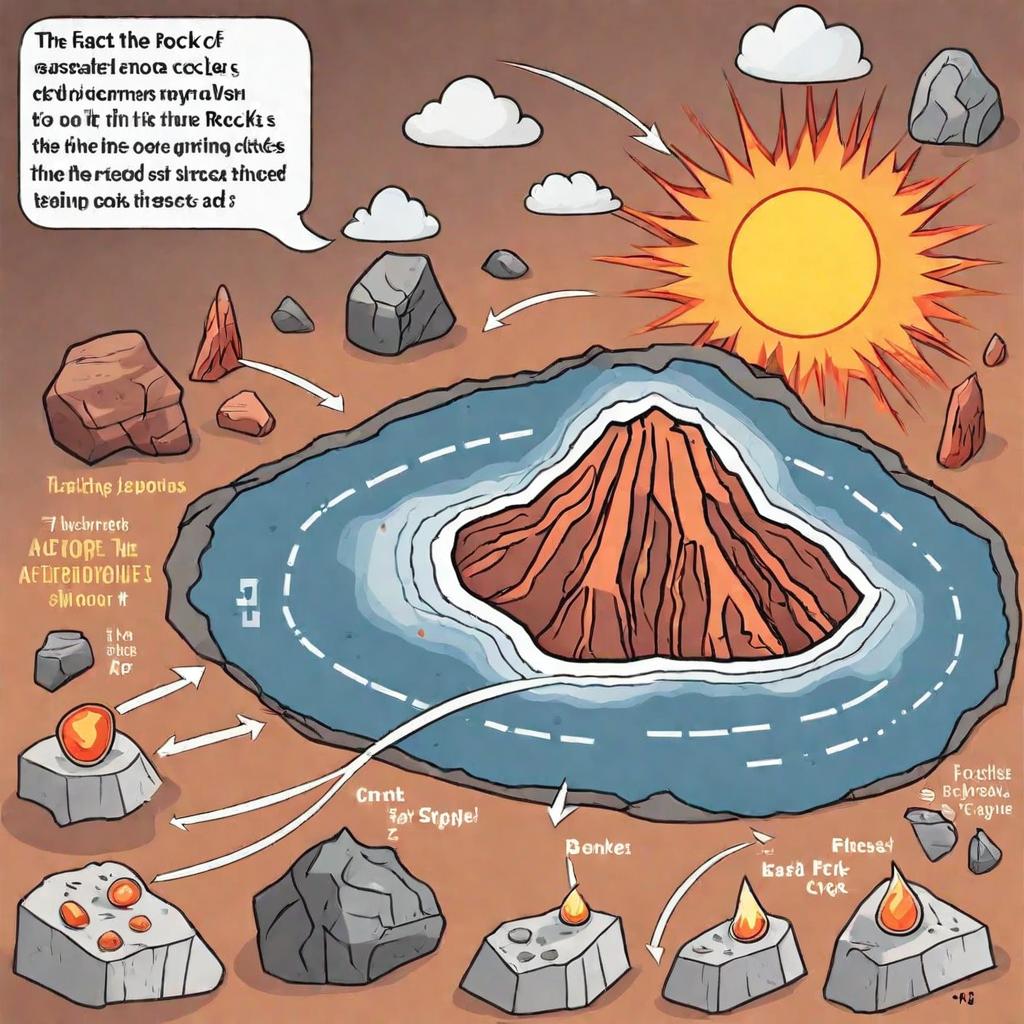
Have you ever picked up a rock and wondered about its journey? 🪨 The rock cycle, a fundamental concept in geology, holds the key to understanding the fascinating life of rocks beneath our feet. But with so much information out there, it’s easy to get lost in a sea of geological jargon and misconceptions.
What if we told you that rocks aren’t as static as they seem? In fact, they’re constantly changing, transforming, and recycling themselves over millions of years. This blog post will unravel the mysteries of the rock cycle, separating fact from fiction. We’ll explore the incredible transformations rocks undergo, the geological processes that drive these changes, and the mind-boggling time scales involved.
Ready to embark on a journey through time and discover which statements truly represent facts about the rock cycle? Let’s dive into the world of igneous, sedimentary, and metamorphic rocks, and uncover the truth behind their eternal dance of creation and destruction.
Understanding the Rock Cycle
The rock cycle is a fundamental concept in geology that describes the continuous transformation of rocks from one type to another over geological time scales. This process is essential for understanding the Earth’s dynamic nature and the formation of various geological features.
Definition of the rock cycle
The rock cycle refers to the ongoing process by which rocks are formed, broken down, and reformed through various geological processes. It encompasses the creation, modification, and destruction of rocks, illustrating the dynamic and ever-changing nature of the Earth’s crust.
Continuous nature of the process
One of the key characteristics of the rock cycle is its continuous nature. The cycle has no definitive beginning or end, as rocks are constantly being transformed through various processes. This continuous cycle can be visualized as follows:
| Stage | Process | Result |
| Formation | Cooling of magma, sedimentation, or metamorphism | New rock formation |
| Weathering | Physical and chemical breakdown | Rock fragments and sediments |
| Erosion and Transport | Movement of rock materials | Deposition in new locations |
| Burial and Compaction | Pressure and heat application | Transformation into new rock types |
Three main types of rocks
The rock cycle involves three main types of rocks, each with distinct characteristics and formation processes:
- Igneous rocks:
- Formed from the cooling and solidification of magma or lava
- Examples: granite, basalt, obsidian
- Formed from the cooling and solidification of magma or lava
- Sedimentary rocks:
- Formed from the accumulation and compaction of sediments
- Examples: sandstone, limestone, shale
- Formed from the accumulation and compaction of sediments
- Metamorphic rocks:
- Formed from the transformation of existing rocks under high pressure and temperature
- Examples: marble, slate, gneiss
- Formed from the transformation of existing rocks under high pressure and temperature
Understanding these rock types and their interrelationships is crucial for grasping the complexities of the rock cycle and its role in shaping the Earth’s surface.
Transformation of Rocks
The rock cycle is a dynamic process that continuously reshapes Earth’s surface. At the heart of this cycle lies the transformation of rocks, driven by various geological forces and environmental conditions.
A. Role of heat and pressure
Heat and pressure play crucial roles in rock transformation:
- Heat: Causes minerals to recrystallize or melt
- Pressure: Compacts and alters rock structure
| Factor | Effect on Rocks |
| Heat | Melting, recrystallization |
| Pressure | Compaction, foliation |
B. Metamorphic to igneous
When metamorphic rocks are subjected to extreme heat, they can melt and form magma. As this magma cools and solidifies, it creates igneous rocks. This process often occurs deep within the Earth’s crust or during volcanic activity.
C. Sedimentary to metamorphic
Sedimentary rocks transform into metamorphic rocks through a process called metamorphism. This occurs when sedimentary rocks are buried deep underground and exposed to high pressure and temperature. The original minerals recrystallize, forming new structures and textures.
Key transformations:
- Sandstone to quartzite
- Limestone to marble
- Shale to slate
D. Igneous to sedimentary
Igneous rocks can become sedimentary through weathering and erosion. This process breaks down the igneous rock into smaller particles, which are then transported and deposited in layers. Over time, these layers compact and cement together, forming sedimentary rocks.
Now that we’ve explored the various transformations rocks undergo, let’s delve into the specific geological processes that drive the rock cycle.
Geological Processes in the Rock Cycle
The rock cycle is driven by various geological processes that continuously shape and reshape the Earth’s crust. These processes are responsible for the formation, transformation, and destruction of rocks over millions of years.
A. Melting and cooling
Melting and cooling are fundamental processes in the rock cycle, particularly in the formation of igneous rocks.
- Melting: Occurs when rocks are subjected to high temperatures and pressures, often in the Earth’s mantle or lower crust.
- Cooling: As molten rock (magma) cools and solidifies, it forms igneous rocks.
| Process | Location | Result |
| Melting | Deep underground | Magma formation |
| Cooling (slow) | Underground | Intrusive igneous rocks (e.g., granite) |
| Cooling (rapid) | Surface | Extrusive igneous rocks (e.g., basalt) |
B. Uplift and exposure
Uplift and exposure bring buried rocks to the Earth’s surface, where they become subject to weathering and erosion.
- Tectonic forces cause uplift of rock formations
- Erosion of overlying layers exposes deeper rock structures
C. Deposition and compaction
These processes are crucial in the formation of sedimentary rocks:
- Deposition: Particles of eroded rock settle in layers
- Compaction: Weight of overlying sediments presses layers together
- Cementation: Minerals bind sediment particles, forming solid rock
D. Weathering and erosion
Weathering and erosion break down existing rocks and transport the fragments:
- Chemical weathering: Rocks decompose due to chemical reactions
- Physical weathering: Rocks break apart due to mechanical forces
- Erosion: Wind, water, and ice transport rock fragments to new locations
These geological processes work together in a continuous cycle, transforming rocks from one type to another over vast periods of time. As we move forward, we’ll explore the timescales involved in these rock cycle processes.
Time Scale of the Rock Cycle
The rock cycle operates on vastly different time scales, ranging from rapid changes to processes that take millions of years. Understanding these timelines is crucial for comprehending the dynamic nature of Earth’s geology.
Examples of rapid and slow changes
- Rapid changes:
- Volcanic eruptions (hours to days)
- Landslides (minutes to hours)
- Earthquakes (seconds to minutes)
- Volcanic eruptions (hours to days)
- Slow changes:
- Mountain formation (millions of years)
- Erosion of large landscapes (thousands to millions of years)
- Metamorphism of rocks (thousands to millions of years)
- Mountain formation (millions of years)
Importance of geological time
Geological time provides context for understanding the rock cycle and Earth’s history. It allows us to:
- Interpret the sequence of geological events
- Estimate rates of change in Earth’s systems
- Predict future geological processes
Varying durations for different processes
| Process | Typical Duration |
| Weathering | Days to millions of years |
| Erosion | Hours to millions of years |
| Transportation | Minutes to thousands of years |
| Deposition | Hours to millions of years |
| Lithification | Thousands to millions of years |
| Metamorphism | Thousands to millions of years |
| Melting | Hours to millions of years |
The rock cycle’s timescale highlights the continuous nature of Earth’s geological processes. While some changes occur rapidly and are observable within human lifetimes, others unfold over millions of years, shaping our planet’s surface and interior. This vast range of timescales underscores the importance of long-term geological studies and the need for patience in understanding Earth’s ever-changing landscape.
Factual Statements About the Rock Cycle
The rock cycle is a fundamental concept in geology that describes the continuous transformation of rocks over time. Here are some key factual statements about the rock cycle:
A. The cycle maintains Earth’s rock supply
The rock cycle ensures a constant supply of rocks on Earth’s surface. Through various processes, existing rocks are broken down, transformed, and recycled into new rocks. This cycle prevents the depletion of any particular rock type and maintains a balance in the Earth’s crust.
B. External forces drive the cycle
The rock cycle is primarily driven by external forces, including:
- Heat from the Earth’s core
- Pressure from tectonic plate movements
- Weather and erosion
- Chemical reactions
These forces work together to create, destroy, and transform rocks over time.
C. All rocks are subject to the cycle
No rock is exempt from the rock cycle. Given enough time and the right conditions, any rock can undergo changes and transform into another type. This includes:
- Igneous rocks
- Sedimentary rocks
- Metamorphic rocks
D. The cycle has no beginning or end
The rock cycle is a continuous process with no fixed starting or ending point. Rocks are constantly changing and recycling, making it impossible to determine a definitive beginning or end to the cycle.
E. Rocks can change form
One of the most fascinating aspects of the rock cycle is the ability of rocks to change form. This transformation can occur through various processes:
| Process | Description | Example |
| Melting | Rocks turn into magma | Granite melting to form lava |
| Cooling | Magma solidifies into igneous rocks | Lava cooling to form basalt |
| Weathering | Rocks break down into smaller particles | Sandstone eroding into sand |
| Compaction | Sediments are pressed together | Sand compressing into sandstone |
| Metamorphism | Rocks change due to heat and pressure | Limestone transforming into marble |
Understanding these factual statements about the rock cycle provides a solid foundation for comprehending Earth’s geological processes and the constant changes occurring beneath our feet.
The rock cycle is a continuous process that shapes and reshapes the Earth’s surface over millions of years. Through the interplay of geological forces, rocks undergo constant transformation, cycling between igneous, sedimentary, and metamorphic forms. This perpetual change is driven by various processes, including weathering, erosion, heat, and pressure.
Understanding the rock cycle is crucial for geologists, environmental scientists, and anyone interested in Earth’s dynamic nature. It reminds us that our planet is in a constant state of flux, with rocks serving as silent storytellers of Earth’s long and complex history. By studying the rock cycle, we gain valuable insights into the processes that have shaped our world and continue to influence its future.



